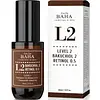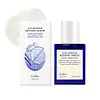What's inside
What's inside
 Key Ingredients
Key Ingredients

 Benefits
Benefits

 Concerns
Concerns

 Ingredients Side-by-side
Ingredients Side-by-side

Aloe Barbadensis Leaf Extract
EmollientPropanediol
SolventGlycerin
HumectantIsononyl Isononanoate
EmollientDimethicone
EmollientNiacinamide
SmoothingBakuchiol
AntimicrobialCetearyl Alcohol
EmollientRetinol
Skin ConditioningCetearyl Olivate
Sorbitan Olivate
Emulsifying1,2-Hexanediol
Skin ConditioningPanthenol
Skin ConditioningTocopheryl Acetate
AntioxidantAllantoin
Skin ConditioningSodium Hyaluronate
HumectantWater
Skin ConditioningButylene Glycol
HumectantArtemisia Vulgaris Extract
Skin ConditioningMelissa Officinalis Leaf Extract
Skin ConditioningLavandula Angustifolia Flower Extract
CleansingRosa Damascena Extract
MaskingCamellia Sinensis Leaf Extract
AntimicrobialXanthan Gum
EmulsifyingAdenosine
Skin ConditioningCaprylyl Glycol
EmollientTromethamine
BufferingCarbomer
Emulsion StabilisingPolysorbate 20
EmulsifyingDisodium EDTA
Tropolone
Skin ConditioningAloe Barbadensis Leaf Extract, Propanediol, Glycerin, Isononyl Isononanoate, Dimethicone, Niacinamide, Bakuchiol, Cetearyl Alcohol, Retinol, Cetearyl Olivate, Sorbitan Olivate, 1,2-Hexanediol, Panthenol, Tocopheryl Acetate, Allantoin, Sodium Hyaluronate, Water, Butylene Glycol, Artemisia Vulgaris Extract, Melissa Officinalis Leaf Extract, Lavandula Angustifolia Flower Extract, Rosa Damascena Extract, Camellia Sinensis Leaf Extract, Xanthan Gum, Adenosine, Caprylyl Glycol, Tromethamine, Carbomer, Polysorbate 20, Disodium EDTA, Tropolone
Water
Skin ConditioningGlycerin
HumectantButylene Glycol
HumectantDibutyl Adipate
Emollient1,2-Hexanediol
Skin ConditioningPanthenol
Skin ConditioningGlycine Soja Oil
EmollientHydrogenated Lecithin
EmulsifyingCaprylic/Capric Triglyceride
MaskingPolyglyceryl-3 Methylglucose Distearate
EmulsifyingSodium Polyacrylate
AbsorbentHydroxyethyl Acrylate/Sodium Acryloyldimethyl Taurate Copolymer
Emulsion StabilisingSodium Acrylate/Sodium Acryloyldimethyl Taurate Copolymer
Emulsion StabilisingBetula Alba Juice
AstringentRetinol
Skin ConditioningBakuchiol
AntimicrobialPolyisobutene
Ethylhexylglycerin
Skin ConditioningAllantoin
Skin ConditioningGlyceryl Acrylate/Acrylic Acid Copolymer
HumectantDisodium EDTA
Sorbitan Isostearate
EmulsifyingPvm/Ma Copolymer
Emulsion StabilisingSorbitan Oleate
EmulsifyingCaprylyl/Capryl Glucoside
CleansingHyacinthus Orientalis Extract
Skin ConditioningBorago Officinalis Extract
EmollientChamomilla Recutita Flower Extract
MaskingCentaurea Cyanus Flower Extract
AstringentSalvia Sclarea Extract
AntiseborrhoeicLavandula Angustifolia Flower Extract
CleansingTocopherol
AntioxidantWater, Glycerin, Butylene Glycol, Dibutyl Adipate, 1,2-Hexanediol, Panthenol, Glycine Soja Oil, Hydrogenated Lecithin, Caprylic/Capric Triglyceride, Polyglyceryl-3 Methylglucose Distearate, Sodium Polyacrylate, Hydroxyethyl Acrylate/Sodium Acryloyldimethyl Taurate Copolymer, Sodium Acrylate/Sodium Acryloyldimethyl Taurate Copolymer, Betula Alba Juice, Retinol, Bakuchiol, Polyisobutene, Ethylhexylglycerin, Allantoin, Glyceryl Acrylate/Acrylic Acid Copolymer, Disodium EDTA, Sorbitan Isostearate, Pvm/Ma Copolymer, Sorbitan Oleate, Caprylyl/Capryl Glucoside, Hyacinthus Orientalis Extract, Borago Officinalis Extract, Chamomilla Recutita Flower Extract, Centaurea Cyanus Flower Extract, Salvia Sclarea Extract, Lavandula Angustifolia Flower Extract, Tocopherol
Ingredients Explained
These ingredients are found in both products.
Ingredients higher up in an ingredient list are typically present in a larger amount.
1,2-Hexanediol is a synthetic liquid and another multi-functional powerhouse.
It is a:
- Humectant, drawing moisture into the skin
- Emollient, helping to soften skin
- Solvent, dispersing and stabilizing formulas
- Preservative booster, enhancing the antimicrobial activity of other preservatives
Allantoin is a soothing ingredient known for its protective and moisturizingg properties. Because of this, it is often added to products with strong active ingredients.
Studies show higher concentrations of this ingredient can promote wound healing.
Though it can be derived from the comfrey plant, allantoin is produced synthetically for cosmetic products to ensure purity.
Learn more about AllantoinBakuchiol is a plant-derived antioxidant (it's vegan!). It is often called the replacement for retinol although it is not part of the same family.
It has similar effects as retinol: skin smoothing, reducing discoloration, and preventing wrinkles. It does not cause as much irritation as traditional retinoids.
Bakuchiol works by breaking down free radicals and stimulating collagen production in skin.
Combining bakuchiol with retinol will not have adverse side effects. Studies show using them will just boost the benefits. Bakuchiol is also found to help stabilize retinol.
While bakuchiol does not make the skin more sun sensitive, we recommend wearing SPF on a daily basis.
Read more about traditional retinol
Learn more about BakuchiolButylene Glycol (or BG) is used within cosmetic products for a few different reasons:
Overall, Butylene Glycol is a safe and well-rounded ingredient that works well with other ingredients.
Though this ingredient works well with most skin types, some people with sensitive skin may experience a reaction such as allergic rashes, closed comedones, or itchiness.
Learn more about Butylene GlycolDisodium EDTA plays a role in making products more stable by aiding other preservatives.
It is a chelating agent, meaning it neutralizes metal ions that may be found in a product.
Disodium EDTA is a salt of edetic acid and is found to be safe in cosmetic ingredients.
Learn more about Disodium EDTAGlycerin is already naturally found in your skin. It helps moisturize and protect your skin.
A study from 2016 found glycerin to be more effective as a humectant than AHAs and hyaluronic acid.
As a humectant, it helps the skin stay hydrated by pulling moisture to your skin. The low molecular weight of glycerin allows it to pull moisture into the deeper layers of your skin.
Hydrated skin improves your skin barrier; Your skin barrier helps protect against irritants and bacteria.
Glycerin has also been found to have antimicrobial and antiviral properties. Due to these properties, glycerin is often used in wound and burn treatments.
In cosmetics, glycerin is usually derived from plants such as soybean or palm. However, it can also be sourced from animals, such as tallow or animal fat.
This ingredient is organic, colorless, odorless, and non-toxic.
Glycerin is the name for this ingredient in American English. British English uses Glycerol/Glycerine.
Learn more about GlycerinLavandula Angustifolia Flower Extract comes from the lavender plant.
Many components of lavender flowers are antioxidants, such as ferulic acid, caffeic acid, and several flavonoids.
Traditional Iranian folk medicine uses Lavender extract to help treat inflammation.
Lavender extract may have a scent.
It contains linalool, a known allergen. However, lavender extract contains less linalool than lavender essential oil.
Learn more about Lavandula Angustifolia Flower ExtractPanthenol is a common ingredient that helps hydrate and soothe the skin. It is found naturally in our skin and hair.
There are two forms of panthenol: D and L.
D-panthenol is also known as dexpanthenol. Most cosmetics use dexpanthenol or a mixture of D and L-panthenol.
Panthenol is famous due to its ability to go deeper into the skin's layers. Using this ingredient has numerous pros (and no cons):
Like hyaluronic acid, panthenol is a humectant. Humectants are able to bind and hold large amounts of water to keep skin hydrated.
This ingredient works well for wound healing. It works by increasing tissue in the wound and helps close open wounds.
Once oxidized, panthenol converts to pantothenic acid. Panthothenic acid is found in all living cells.
This ingredient is also referred to as pro-vitamin B5.
Learn more about PanthenolRetinol is a gold-standard ingredient for anti-aging. It is a form of Vitamin A and belongs to the class of retinoids that also includes tretinoin.
Why is retinol famous?
It has the most scientific studies backing up its skin benefits out of all the non-prescription ingredients.
Retinol is proven to:
This is why retinol is effective at removing wrinkles, fading dark spots, treating acne, and reducing the appearance of pores.
Studies show retinol is less effective when exposed to UV. Be sure to look for appropriate packaging to keep your retinol potent (similar to Vitamin C).
Using retinol or any retinoids will increase sun-sensitivity in the first few months. Though studies show retinoids increase your skin's natural SPF with continuous use, it is best to always wear sunscreen and sun-protection.
We recommend speaking with a medical professional about using this ingredient during pregnancy.
Retinol may cause irritation in some people, so be sure to patch test. Experts recommend 'ramping up' retinol use: start using this ingredient once a week and work up to using it daily.
Read about Tretinoin
Learn more about RetinolWater. It's the most common cosmetic ingredient of all. You'll usually see it at the top of ingredient lists, meaning that it makes up the largest part of the product.
So why is it so popular? Water most often acts as a solvent - this means that it helps dissolve other ingredients into the formulation.
You'll also recognize water as that liquid we all need to stay alive. If you see this, drink a glass of water. Stay hydrated!
Learn more about Water